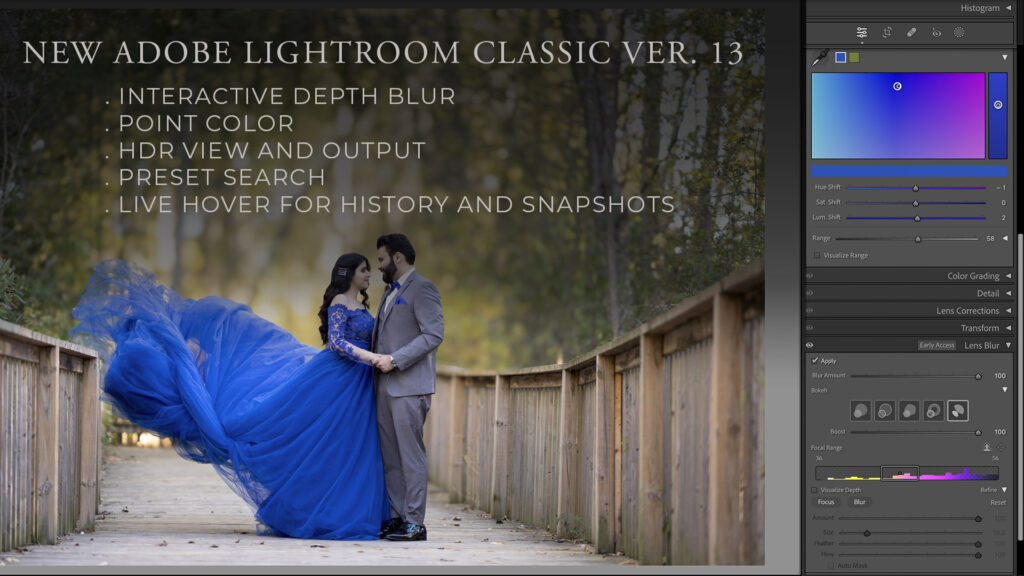Major Update of Adobe Lightroom Classic Ver 13 LIVE BLUR AND POINT COLOR
Major Update of Adobe Lightroom Classic Ver 13 LIVE BLUR AND POINT COLOR
Subscribe to YouTube
Adobe Lightroom Classic Ver 13
Adobe has unveiled its latest update, Adobe Lightroom Classic Ver 13 Oct. 2023, featuring notable enhancements, including the introduction of Lens Blur and Point Color. While this release offers some minor updates like searchable presets, the standout additions are Point Color and Lens Blur.
Point Color empowers users to select specific colors or color ranges and make adjustments accordingly. However, for more precise control over hue, saturation, and lightness adjustments, Adobe Photoshop remains the preferred choice, providing extensive capabilities and non-destructive editing options.
The most significant feature in Adobe Lightroom Classic Ver 13 is Lens Blur, essentially a depth blur effect. Although Adobe has incorporated depth blur in the Neural Engine of Adobe Photoshop for a while now, the implementation in Adobe Lightroom Classic Ver 13 is notably more user-friendly and intuitive. Many users may still opt to use it as a non-destructive smart filter within Adobe Photoshop, but its inclusion in Camera Raw is a valuable enhancement.
For a comprehensive overview of these new features and how to utilize them, I encourage you to watch my video tutorial provided above for Adobe Lightroom Classic Ver 13.
All my tutorials were design after my college courses as supplemental material. All of the Adobe programs take time to learn. Jumping in to learn a specific feature is not suggested until you learn the basics. Learning Photoshop or Adobe Lightroom is a two step process. How it works, and then what to do.
Adobe Lightroom Classic 2023 introduces Lens Blur and Point Color!
john whitehead images
Items Covered in this Video

What’s New in the Adobe Lightroom Classic Ver 13. I will focus on the two new main elements, Point Color, and Lens Blur
Lightroom Classic and Adobe Camera Raw use the same program to process Raw files.
Adobe Camera Raw (ACR) is a powerful and versatile software tool developed by Adobe Systems, primarily designed for processing and editing raw image files. Here’s an in-depth look at its key features and functionalities:
Raw Image Processing: ACR’s primary purpose is to process raw image files, which are unprocessed sensor data captured by digital cameras. Raw files contain more image information and provide greater flexibility for adjustments compared to JPEG or other compressed formats.
Non-Destructive Editing: A significant advantage of ACR is its non-destructive editing capability. When you make adjustments to a raw image in ACR, the changes are stored as metadata, leaving the original raw data untouched. This means you can revisit and modify your adjustments at any time without losing image quality.
User Interface: ACR’s user interface is user-friendly and intuitive. It typically appears as a panel within Adobe Photoshop or as a module in Adobe Lightroom. The interface consists of sliders, buttons, and other controls for making adjustments.
Basic Adjustments: ACR provides essential tools for adjusting exposure, contrast, brightness, highlights, shadows, and saturation. These adjustments allow you to fine-tune the overall look and feel of your images.
White Balance Control: You can set the correct white balance to ensure accurate color representation in your photos. ACR offers various options, including preset settings and the ability to set a custom white balance.
Tone Curve: ACR includes a tone curve tool that allows for precise control over tonal adjustments. You can make selective changes to highlights, midtones, and shadows.
Lens Corrections: ACR can automatically detect and correct common lens distortions like chromatic aberration, distortion, and vignetting. Users can also manually apply adjustments to correct lens-related issues.
Noise Reduction: ACR includes tools for reducing noise in images, particularly in high-ISO shots. You can balance noise reduction with image detail preservation to achieve the desired image quality.
Sharpening: ACR provides sharpening tools to enhance image detail and clarity. Users can adjust the amount, radius, and detail of sharpening to optimize the image for its intended use.
Local Adjustments: ACR allows for local adjustments, including graduated filters and adjustment brushes. This feature enables precise edits in specific areas of an image, such as darkening a sky or brightening a subject’s face.
Grayscale Conversion: You can easily convert color images to black and white within ACR. It offers several methods for achieving different black-and-white looks.
Presets: ACR supports the creation and use of presets, which are pre-defined sets of adjustments that can be applied to images for a consistent look. Users can create and save their presets or use Adobe-provided ones.
Histogram and Image Information: ACR displays a histogram and detailed image information (e.g., camera settings, lens details, and exposure data), helping users make informed editing decisions.
Batch Processing: ACR allows batch processing of multiple images, making it efficient for editing and exporting a large number of photos with the same adjustments.
Integration: ACR seamlessly integrates with Adobe Photoshop and Adobe Lightroom. Users can open raw files directly in ACR, apply adjustments, and then continue editing in Photoshop or Lightroom.
Adobe Camera Raw is an indispensable tool for professional and enthusiast photographers who seek the highest image quality and editing flexibility. It plays a central role in many digital photography workflows, providing extensive control over the editing process while preserving the integrity of the original raw data.
I have a Facebook Group called, “Learn Adobe Lightroom, Photoshop, and Bridge.” I created this group because I get a lot of questions on YouTube that are hard to answer unless I can see the issue. This will allow a place you can ask questions, and more importantly post images and videos.


